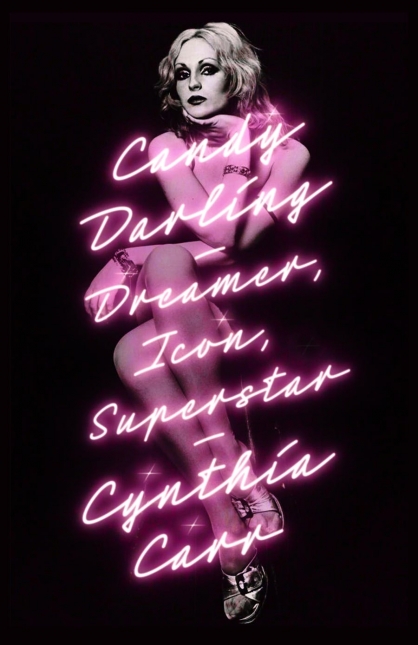Candy Darling: Dreamer, Icon, Superstar
- By Cynthia Carr
- Farrar, Straus and Giroux
- 432 pp.
- Reviewed by Rose Rankin
- April 8, 2024
A timely, tragic portrait of a transgender actress whose ambition couldn’t overcome discrimination.

With over 470 anti-LGBTQ bills currently under consideration in state legislatures across the U.S., it’s a critical time to push back against the transphobia — evident in things like denied medical care and intimidation at drag brunches — impacting people’s lives. This makes the timing of Cynthia Carr’s new biography of transgender actress Candy Darling fortuitous. Although it’s unfortunately flawed, Candy Darling is still a valuable cautionary tale of what happens to actual human beings when trans rights are disrespected or, worse, nonexistent.
Born in 1944, Darling began life as James Slattery, the youngest in a terribly abusive family and an outcast at school from an early age. Carr interviewed acquaintances and neighbors and accessed interviews from decades past (recorded by a later friend of Darling’s) to depict the abject loneliness and heartbreaking bullying Darling was subjected to throughout her childhood.
She knew she was a woman from a young age, but terms such as “gender dysphoria” didn’t exist in the 1950s and 1960s, and homosexuality was illegal. When Darling finally left the suburbs of Long Island for New York City, she began presenting herself as a woman and found camaraderie with other “street queens.” But even there, transgender people (another term that didn’t exist at the time) were discriminated against in the LGBTQ community; the presence of “cross-dressers” in a club was an easy excuse for the police to raid the place, so they were constantly harassed.
Always obsessed with Hollywood, Darling sought out acting work and landed her first Off-Off-Broadway role in 1967. She also met Andy Warhol around this same time while acting in another small production. Becoming part of his crew meant she gained some notoriety in avant-garde circles, and she appeared in a handful of Warhol’s films and photoshoots, as well as in additional Off-Off-Broadway shows.
Carr treats these works as if they were major motion pictures or Broadway smashes, which is disconcerting for the reader because their names (“Glamour, Glory and Gold,” “Vain Victory,” etc.) are obscure and, as the author herself recounts, few had actual scripts or even a stable cast, much less commercial success. Extant reviews universally panned these productions. Nonetheless, at this time in her life, Darling began referring to herself as a “star.” Carr fully agrees with that designation, repeatedly describing Darling as a “superstar” despite zero evidence that she was known outside of a small cadre of Warhol hangers-on.
Carr does well, however, to utilize Darling’s diaries as source material — they provide an intimate glimpse of her inner life, which was tortured and lonely and utterly different than the glamorous external persona she worked so hard to create. As she confided in one entry, “I feel like I’m living in a prison…I see so much of life I cannot have.”
During the late 1960s and early 1970s, Darling continued acting in small roles, including one in Tennessee Williams’ “Small Craft Warnings” in 1972. Sadly, even in that moment of triumph, the other actors refused to share a dressing room with her, and she was relegated to changing in a broom closet. Throughout this period, she had no permanent home and hopped among friends’ couches. Quality medical care for gender transitioning was unavailable, and despite her proximity to Warhol, she was mostly penniless — unable to afford even basic dental care. Carr tells multiple stories of Darling losing teeth in public.
The backdrop to this painful personal tale is the social upheaval of the time, namely the women’s-liberation and gay-rights movements. Darling didn’t participate in any marches or events, and the lack of analysis as to why not is among the book’s biggest misses. Carr frequently scratches the surface of an event like the Stonewall riot, but just as she’s about to explore Darling’s reaction (or lack thereof) to it, she jumps to yet another meandering story about the Warhol-adjacent performance artists she treats like household names.
By 1973, Darling had developed a tumor in her stomach. She underwent surgery and chemotherapy but passed away from cancer shortly after her 29th birthday in 1974. A physician diagnosed it as lymphoma, but there’s little explanation here of the possible cause — only an allusion to the black-market hormone pills, obtained from unlicensed doctors, that Darling took for many years. Her death became as ephemeral as her life, and her own family sought to erase her memory once she was gone.
There is no sugarcoating this tragic story. No matter how much Carr tries, proclaiming Darling to be a superstar only shows how far from fame she really was, and how she was thwarted at every turn in her attempt to live the life she wanted.
It’s comforting, at first, to imagine Darling would’ve appreciated a biography like this, but on deeper reflection, it’s likely she would have preferred an entirely fabricated tale. Her actual life story demonstrates why transgender people must be treated as human beings. When they aren’t, they are left to suffer mercilessly.
Rose Rankin is a freelance writer from Chicago. She focuses on history, science, and gender issues, in particular women’s literary history.

